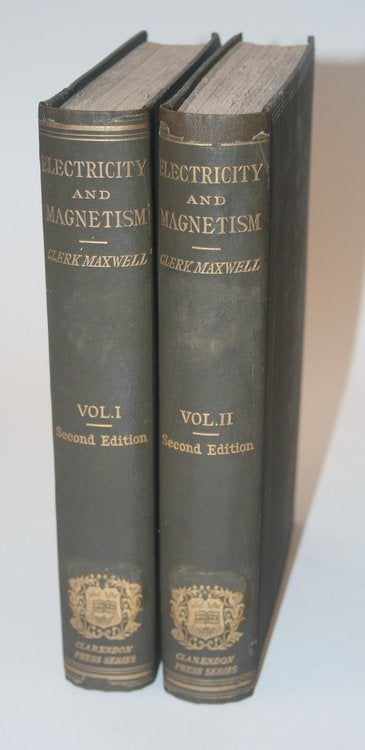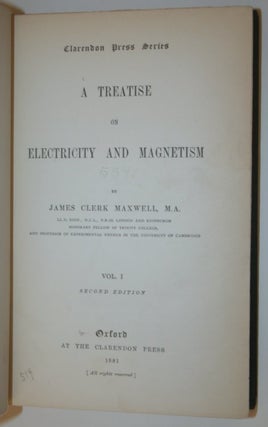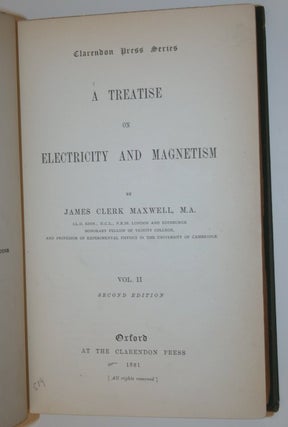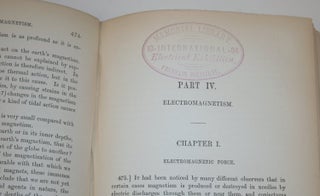A Treatise on Electricity and Magnetism ... Second Edition
Oxford: At the Clarendon Press 1881. Second Edition. Two volumes, 8vo. Volume One: xxxi, [1-blank], [1]-464,[1-plate half title],[1-blank] pages + thirteen lithographed plates (I-XIII). An additional plate (marked Fig 6) is present opposite page 170. Volume Two: xxiii, [1-blank], [1]-456, [1-plate half title],[1-blank] pages, seven plates (XIV-XX) + 40 pages advs dated Nov 1883. 21 plates total. Publisher's original blind stamped olive green cloth. Top edges dusty. Both volumes with lightly bumped corners, professionally re-backed with original spines laid down and endpapers preserved. Generally bright and clean internally. Ex-Franklin Institute Library ("Memorial Library of the International Electrical Exhibition 1884, presented by Clarendon Press 7.21.84") with labels on front pastedowns, and evidence of removed spine labels. Vol One: A few penciled previous owner/dealer notations on flyleaves but bright and clean otherwise with no additional markings. Vol Two: Also generally bright and clean, noting the enthusiastic use of a fancy purple "Memorial Library International Electrical Exhibition 1884 Franklin Institute" ink stamp throughout. Part of the Clarendon Press Series. Very Good. Cloth. [28131]
"Maxwell here advanced the significant hypothesis that light and electricity are the same in their ultimate nature." (Horblit/Grolier)
"Maxwell once remarked that the aim of his Treatise was not to expound the final view of his electromagnetic theory, which he had developed in a series of five major papers between 1855 and 1868; rather, it was to educate himself by presenting a view of the stage he had reached in his thinking. Accordingly, the work is loosely organized on historical and experimental, rather than systematically deductive lines. It extended Maxwell's ideas beyond the scope of his earlier work in many directions, producing a highly fecund (if somewhat confusing) demonstration of the special importance of electricity to physics as a whole. He began the investigation of moving frames of reference, which in Einstein's hands were to revolutionize physics ; gave proofs of the existence of electromagnetic waves that paved the way for Hertz's discovery of radio waves; worked out connections between the electrical and optical qualities of bodies that would lead to modern solid-state physics; and applied Tait's quaternion formulae to the field equations, out of which Heaviside and Gibbs would develop vector analysis." (Norman)
This copy of Maxwell's important treatise contains a forty page publisher's catalog at end of volume two dated November 1883. While most copies of the second edition we've seen have a thirty-six page publisher's catalog dated Sept 1881 (plus six additional ad pages), this example, (presented by publisher Clarendon Press to the Franklin Institute Library for it's Memorial Library of the 1884 International Electrical Exhibition) was bound with the latest catalog available. The 1884 International Exhibition was a monumental event and the Franklin Institute memorialized it with a special library where this volume originally resided. The Franklin Institute Library was sold off many years ago to the delight of today's collectors. The third edition of this work wasn't published until 1892.
"Throughout the 19th century, Philadelphia's Franklin Institute was often the organizer of American-held international exhibitions that showcased the achievements of industrial civilization. For example, it played a key role in organizing and hosting the International Electrical Exhibition of 1884 in Philadelphia. This, the first great electrical exposition in the United States, was held from September 2 to October 11, 1884...The show featured the displays of 196 commercial exhibitors and 1,500 exhibits, including a historical exhibit that featured devices used by Benjamin Franklin and the first Morse telegraph instrument. The novel application of electricity to the running of a railroad train, printing presses, sewing machines was demonstrated, as was an electrical searchlight, which had never been seen before...More than 285,000 people attended the International Electrical Exhibition of 1884, which was held in a large building built for this purpose at 32nd Street and Lancaster Avenue. The landmark exposition resulted in the formation of the American Institute of Electrical Engineers, an ancestor of today's Institute of Electrical and Electronics Engineers. During the International Electrical Exhibition, the National Conference of Electricians was convened on September 8–13, 1884, at the Franklin Institute. This was the first national convention of electricians in the nation. The summit was authorized and organized by the United States Electrical Commission, which President Chester A. Arthur had formed earlier that year under an act of Congress. It was funded to the amount of $7,500 by the federal government." (wikipedia)
Literature: Referencing the first edition: Grolier/Horblit #72. ("The first edition of Clerk Maxwell's epoch-making work."). Norman, #1466 (referring to 1st ed, second issue). Printing & the Mind of Man, 355 ("Clerk Maxwell, who may well be judged as the greatest theoretical physicist of the nineteenth century". Ekelof, #1164 (second edition, also with a 40 page publisher catalog). Wheeler Gift #1872a. "The most important changes made in this [second] edition are in the first nine chapters. It was prepared by W. D. Niven of Trinity College, Cambridge."
ITEM SOLD






